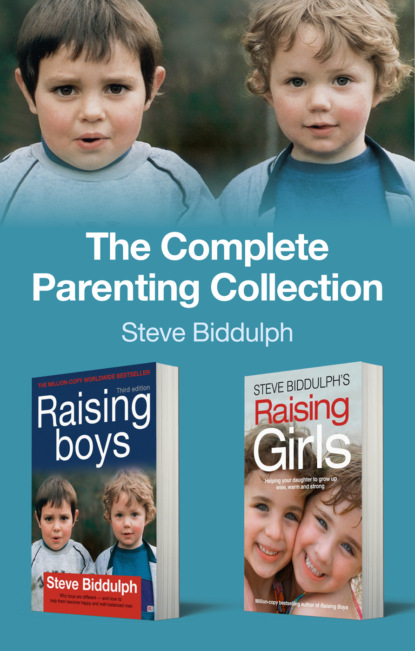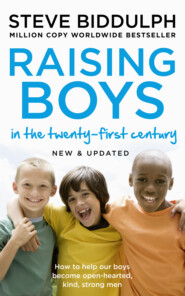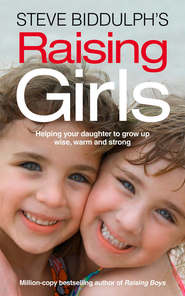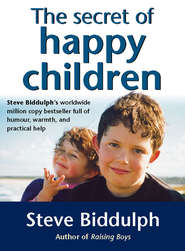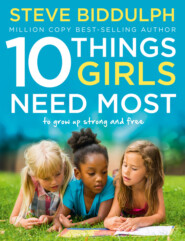По всем вопросам обращайтесь на: info@litportal.ru
(©) 2003-2024.
✖
The Complete Parenting Collection
Автор
Год написания книги
2018
Настройки чтения
Размер шрифта
Высота строк
Поля
The women’s work of gathering seeds, roots and insects was different. It allowed time for discussion, required finger dexterity and sensitivity, and included the care of babies and children. As a result, human females have finger sensitivity several times greater than males. The women’s work required caution, constancy and attention to detail – whereas hunting required a certain degree of recklessness, or even self-sacrifice. Women’s bodies became generally smaller but better able to persist and endure. Men’s bodies were better at rapid bursts of strength but were more likely to be laid low by a dose of flu or an ingrown toenail! The differences were not great, and some role flexibility probably helped. So we ended up a species with slight but significant differences between male and female bodies and brains.
The hunter-gatherer tradition continues to have a problematic legacy. In the developing world (where many people still live by agriculture), the men often do not work as hard as the women. Presumably they are waiting to fight someone or hunt something!
The links between sex and aggression
There is some support from primate studies for the idea that males with more power have higher sex drives. Men in sports teams that win have a higher testosterone level (after the game) than those who lose. And, according to historians, many great leaders (US President Kennedy, for instance) had very high sex drives, to a degree that was really rather tragic and disabling (it’s kind of hard to run a country when you want to keep racing off to have sex all the time).
One study of juvenile delinquency in the 1980s found an intriguing connection – that boys were several times more likely to get into trouble with the police in the six months before their first sexual experience. In other words, they calmed down a bit once they started having sex. Since almost all boys masturbate at this age, it can’t just have been the release of sexual frustration. Perhaps the boys felt they had ‘joined the human race’ when they found a real-life lover; perhaps they felt more loved. (We don’t recommend this as a cure for crime, but it makes sense.)
Sex and aggression are somewhat linked – controlled by the same centres in the brain and by the same hormone group. This has been the source of enormous human tragedy and suffering, inflicted via sexual assaults on women, children and men. Because of this connection, it is very important that boys are helped to relate to women as people, to have empathy and to learn to be good lovers.
Blaming hormones is never an excuse for male aggression; and it’s vital that we separate the stimuli of violence from the stimuli of sex. We shouldn’t really make or show movies that link the two. The rape-revenge plot of many B-grade movies is a bad connection to make. Most pornography in fact is pretty dismal role-modelling for good relating or sensitive and joyous loving. Where are the movie depictions of tender, sensuous, playful and boisterous lovemaking, with plots that include conversation, sharing and vulnerability, so that mid-adolescent boys can learn a fuller kind of sexuality?
Even adult men can get the wrong idea. A matchmaking agency recently had to counsel a man in his sixties who was being far too sexually forward on ‘dates’ that the agency arranged. The man, a very gentle and considerate farmer (widowed two years earlier), had researched copies of Cosmopolitan magazine to find out what today’s women liked, and was acting accordingly!
Overcoming sexual violence probably starts younger still. It may just come down to treating children more kindly. Raymond Wyre, a British expert on working with men who sexually abuse children, found in his work that while not every sex offender had been the victim of sexual assault (though many had), everyone without exception had been the recipient of a very cruel and uncaring childhood. It was the lack of empathy, resulting from never having been shown consistent understanding and kindness, that he felt was the key factor in someone being able to sexually assault another human being.
Guiding the ‘high-drive’ boys
Testosterone provides energy and focus. A boy with high levels of the hormone makes good leadership material. Early in the school year, teachers often notice a certain kind of boy who will either become a hero of the class or a complete villain. For this boy there is no middle ground. This type of boy stands out by his:
challenging behaviour and competitiveness
greater physical maturity, and
high energy levels.
If the teacher is able to befriend such a boy and direct his energies in good ways, the boy will thrive and be a plus in the school. If the teacher or parent ignores, backs off or is negative towards the boy, then the boy’s pride will depend on defeating the adult, and problems will compound. These boys have leadership potential, but leadership has to be taught from an early age.
IN A NUTSHELL
Testosterone in varying degrees affects every boy. It gives him growth spurts, makes him want to be active, and makes him competitive and in need of strong guidelines and a safe, ordered environment.
It triggers significant changes:- at four – into activity and boyishness- at thirteen – into rapid growth and disorientation, and- at fourteen – into testing limits and breaking through to early manhood.
The boy with testosterone in his bloodstream likes to know who is the boss, but also must be treated fairly. Bad environments bring out the worst in him. The boy with lots of testosterone needs special help to develop leadership qualities and to channel his energies in good ways.
A boy needs to learn empathy and feeling, and be shown tenderness if he is to be a sexually caring being.
Some girls have a lot of testosterone but, on the whole, it’s a boy thing – and it needs our understanding, not blame or ridicule. Testosterone equals vitality, and it’s our job to honour it and steer it in healthy directions.
Chapter 4 How boys’ and girls’ brains differ (#ulink_eea083ba-0bfb-5f20-894c-35300bb8732c)
Twenty years ago, we rarely acknowledged differences in the brains of boys and girls, for fear this would imply gender inequality. Today we know that there are numerous differences, and by understanding these, we can build on boys’ and girls’ strengths and address their weaknesses, so both can be the best they can. For parents this can be a real revelation.
A miracle of growth
The brain of a baby in the womb grows very rapidly, developing in a month or two from just a few cells into one of the most complex structures in nature. By the sixth month of pregnancy, a foetus has impressive abilities, all controlled by its brain – such as recognising your voice, responding to movements, even kicking back when prodded! It can be seen with ultrasound to be actually moving its mouth as if it is singing in the womb.
At birth the brain is still only partially formed and only a third of its eventual size. It takes a long time for the brain to be completed. For instance, the language part of the brain is not fully formed until about the age of thirteen, which is why it is so important that boys are kept up with reading through the primary school years.
From very early on, gender differences are evident in the unborn baby’s brain. One difference is that a baby boy’s brain develops more slowly than a baby girl’s. Another difference is that the left and right sides are less well connected in a boy.
All animal brains have two halves. In simple animals (like lizards or birds) this means that everything is duplicated. A bang on the head might wipe out part of one half of the brain, but the other half can take care of things! However, in humans (who have a lot more to think about), the two brain halves specialise somewhat. One half handles language and reasoning; the other, movement, emotion and the senses of space and position. Both halves ‘talk’ to each other via a big central bundle of fibres called the corpus callosum. The corpus callosum in boys is proportionately smaller in size, so there are fewer connections running from one side to the other.
Boys tend to attack certain kinds of problems (such as a spelling quiz or word puzzle) using only one side of their brain, while girls use both sides. Magnetic resonance imaging (MRI) brain-scanning technology shows us that: the ‘lights go on’ all over a girl’s brain, while in a boy they tend to be localised on one part of one side only.
Why the difference?
The brain of a baby before and after birth grows rather like a tub of alfalfa sprouts accidentally left in the sun – brain cells keep getting longer and making new connections all the time. The left half of the cortex grows more slowly than the right in all human babies, but in males it is even slower still. The testosterone in a boy’s bloodstream slows things down. Estrogen, the hormone that is predominant in the bloodstream of baby girls, actually stimulates faster growth of brain cells.
As the right half grows, it tries to make connections with the left half. In boys, the left half isn’t yet ready to take the connections, so the nerve cells reaching across from the right cannot find a place to ‘plug in’. So they go back to the right side and plug in there instead. As a result, the right half in a boy’s brain is richer in internal connections but poorer in cross connections to the other half. This is one possible explanation of boys’ greater success in Mathematics, which is largely a ‘right side of the brain’ activity (and their greater interest in taking machinery to pieces and leaving the bits lying around!). But we must be careful not to overdo these conclusions, as sometimes parental expectations, practice and social pressure also influence skills and abilities. It’s clear that practice actually helps more brain connections to be laid down permanently, so encouragement and teaching actually affect the shape and power of the brain in later life.
PRACTICAL HELP
LEARNING TO COMMUNICATE
Communication is essential to life. Yet sadly, in every classroom, there are usually four or five children who can’t read, write or speak well. And among these children, boys outnumber girls by four to one! This is now thought to be the result of boys’ brains not being quite so well organised for language.
But there is no need to just let this be. If you want to prevent your child having learning or language problems, there is a lot you can do to help, according to neuroscientist Dr Jenny Harasty. Dr Harasty and her team found that in females, two regions of the brain dedicated to handling language are proportionately 20 percent to 30 percent larger than in males. But no-one knows whether these regions are larger at birth or because girls get more practice at using them, causing them to grow. Whatever the cause, we do know that the brain is very responsive to learning experiences if these are given at the right age. And for language, that age is zero to eight. In adolescence and adulthood we go on learning, but the older the child, the harder it is to change that early wiring of the brain.
You can help your boy learn to communicate better, starting right from when he is a baby. This means that he will be a better reader, writer and speaker when he goes to school. Here’s how …
1. ‘TALK THEM UP’ – ONE STEP AT A TIME
Children acquire spoken language one step at a time. Babies under one year of age will begin to babble and gesture very enthusiastically, telling us they are ready to learn verbal communication! This is the time to start to teach them words.
With a baby who babbles, repeat a word that seems to be what he means. Baby says ‘gukuk, baguk!’ and points to his toy duck. You say ‘Ducky! John’s ducky!’ Soon John will be saying ‘Ducky’ too.
With a toddler who says single words, like ‘milk!’, you say a couple of words, such as ‘milk bottle’. This helps him to move on to joining pairs of words together, and so on.
A child who is saying words in twos and threes can be stretched further by imitating you in whole sentences. For example, he says, ‘Gavin truck!’ You reply, ‘Gavin wants a truck? Here’s Gavin’s truck!’ And so on.
In short, kids learn best if you speak back to them one step ahead of the stage they are at. And they love the game – all human beings love to communicate.
2. EXPLAIN THINGS TO CHILDREN EVERY CHANCE YOU CAN
This is a great use of the many times when you are just doing routine things with your children – travelling, doing housework, going for a walk, doing the shopping. Use this time to chatter, to point things out, and to answer questions. Surprisingly, some very loving parents (who care for their kids well) seem not to realise that kids’ brains grow from conversation. Don’t be shy – explain things, tell them stories! For example, ‘You see this lever? This makes the wipers go. They swish the rain away from the window.’ ‘This vacuum cleaner makes a big wind. It sucks the air and pulls the dirt into a bag. Would you like a turn?’
This kind of talk – provided you don’t overdo it and bore your child senseless – does more for your child’s brain than any amount of expensive education later on.
3. READ TO YOUR KIDS FROM AN EARLY AGE
Even when your child is just one year old, you can enjoy books together – especially the kind that have rhymes and repetition. ‘Humpty Dumpty’ and ‘Twinkle Twinkle Little Star’ work just fine. From enjoying them on your knee or snuggled up in bed, children learn to love books, looking at the pictures and enjoying the sound of your voice. You can ‘ham it up’ a little by making funny voices or by being dramatic.
As your child gets to have favourite stories, you can play a ‘predicting’ game: ‘And the little cat went …?’, pausing so your child provides the ‘Miaow!’. Prediction is a very important part of reading. Good readers anticipate what word is coming next.
Remember, whenever you’re playing learning games with kids, the trick is to be playful, making your children ‘stretch’ their minds just a little – which they will love to do.





